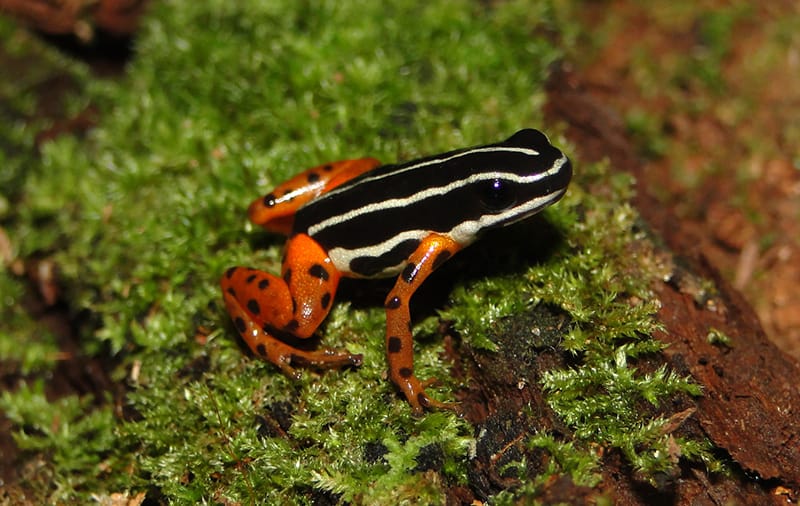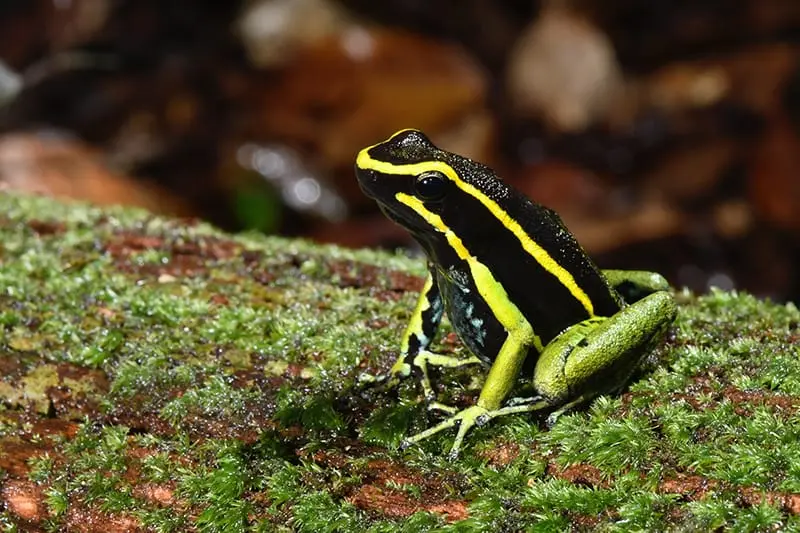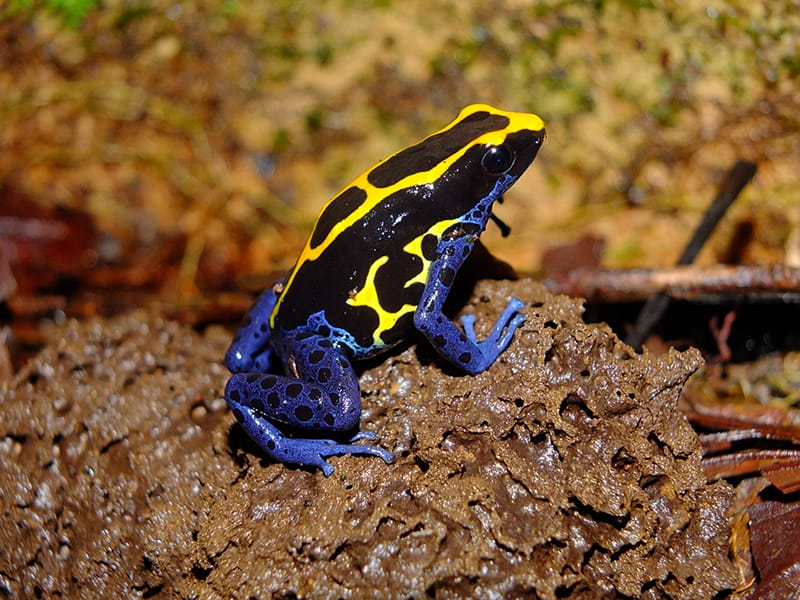Poison dart frogs of South America
The dendrobatids are a family of small frogs between 1 and 6 cm (0.39 and 2 inches) long, including the famous poison dart frogs - one of the most venomous animals in the world. Last revised in 2006, the family has undergone several taxonomic changes and is now considered to have 16 genera and about 200 species distributed throughout the humid forests of Central and South America.
In Brazil, there are 4 genera and about 21 species present in most of the country, mainly in Amazônia. These small poisonous frogs are terrestrial and (unlike most frogs) diurnal. They usually live on the forest floor near streams and ponds, but some can live high in the trees without ever coming down.
In many species, the parents are devoted to raising their tadpoles to adulthood. In some, the females lay their eggs on land, and then the male fertilizes them. In frogs of the genus Ranitomeya (for example) when the tadpoles are born, they are carried on their parents' backs to small pools of water such as those accumulated in bromeliads. There, the tadpoles feed on small invertebrates and unfertilized eggs that the mother takes to supplement the diet of her tadpoles.
Aposematism

Aposematic colors are the bright colors displayed by many species (yellow, red, blue) that can be used as a defense mechanism against predators, sending warning signals about the toxicity of that animal. Predators, on the other hand, learn (instinctively or from experience) that this animal is not to be eaten. Dendrobatids are probably the most common aposematic vertebrates.
In most species, the toxicity of each individual’s skin can vary according to how conspicuous its coloration is. In addition, females choose mates based on the most vibrant coloration - so their tadpoles will be even more colorful, increasing their chances of survival.
The Dyeing poison dart frog Dendrobates tinctorius, for example, has one of the largest color variations within the same species, ranging from black with yellow stripes to completely dyed blue and yellow with black spots. Such is the difference that some scholars suspect that they are actually different species.
Poison

Dendrobatids feed on termites, mites, beetles, ants and other small arthropods. Some of these insects feed on toxic plants, and when swallowed by these toads, the toxicity of the plant and thus of the insect that ingested it is transmitted to the glands present in the skin of the poison dart frogs. When one of these frogs is captured, the predator may experience various symptoms such as unpleasant taste, nausea, or muscle paralysis. In the case of small predators, however, it can be fatal.
The most dangerous species is the Phyllobates terribilis — present only in Colombia. It produces about 20 times more toxin than other dendrobatids. If the frog were to be ingested, its venom would be strong enough to kill an average of ten to twenty men. While most other dendrobatids are toxic enough to discourage predators, they pose much less of a risk to humans or large animals.
Reports and studies on dendrobatid poisoning are very scarce, but in 2021, one article reported two cases of mild poisoning after unprotected handling of the species D. tinctorius. In the report, two photographers handled the animal for about 5 minutes and then (even after washing their hands) felt a slight numbness in the areas of the body that had direct or indirect contact with the animal’s skin where the toxins are located. No medical or emergency care was required in this case.

However, the situation could be very different if the toxin is accidentally swallowed or enters the bloodstream through a wound. Therefore, it is recommended that these animals be handled only with gloves. Some Colombian indigenous tribes, for example, use the venom of the P. terribilis in their darts, but always protect their hands with leaves.
Conservation
Many of these frogs are at some degree of extinction or are so poorly known that there is insufficient data on their population and distribution. While some of their populations are considered stable, others are threatened by habitat loss and illegal collection for the pet trade. According to the Chico Mendes Institute, one of the biggest threats to its conservation is the trafficking of animals for breeding as “pets”, being among the most targeted animals in Brazil.
Read more at:
Os coloridos sapos-ponta-de-flecha: pequenos no tamanho e gigantes em beleza e veneno
Multiple, recurring origins of aposematism and diet specialization in poison frogs
Rare Splash-backed Poison Frogs are Anything But ‘Blue’ as They Fly Home to Brazil
